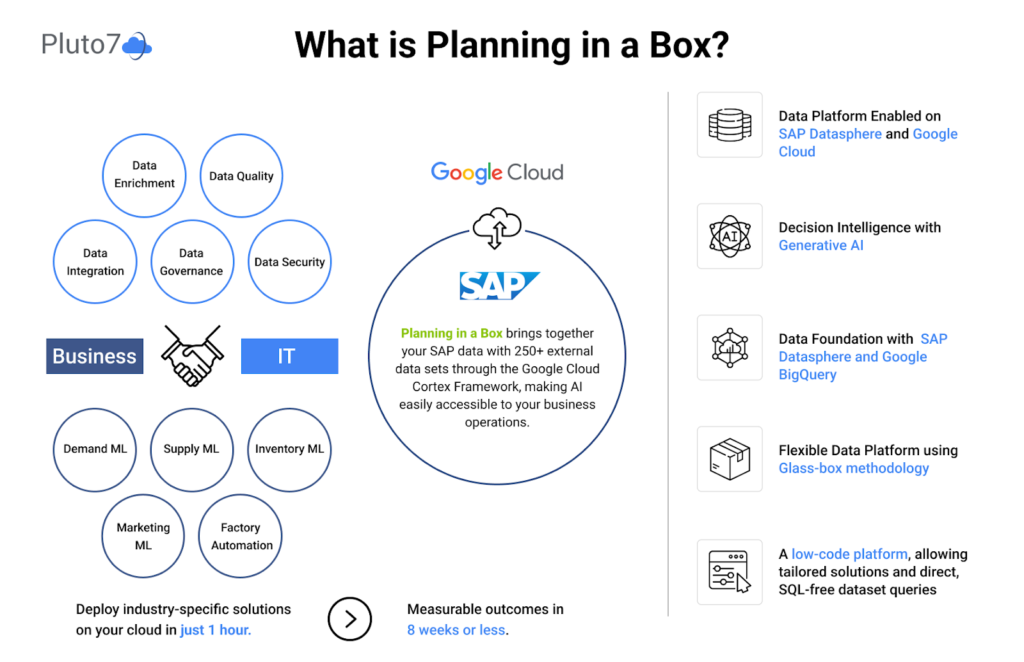
Transform Your Supply Chain Planning and Marketing Strategies with Google Cloud and SAP Integration

Transform Your Supply Chain Planning and Marketing Strategies with Google Cloud and SAP Integration
July 18, 2023 | Premangsu Bhattacharya
Blog / Catching the ‘Barbenheimer’ Wave: Leveraging Viral Trends with ‘Planning in a Box’
 Image source: The Times
Image source: The Times
When Hollywood churns out two big-banner movies and unintentionally births a viral phenomenon known as ‘Barbenheimer,’ the retail industry takes notice. As a retailer, the trick lies in quickly deciphering and using these trends to your advantage.
Whether it’s ‘Barbenheimer’ shirts trending on Amazon, or a demand surge for Barbie-themed products like Xbox consoles and Krispy Kreme collaborations, these trends impact demand patterns. ‘Barbenheimer,’ the phenomenon in question, is not just a meme; it’s a valuable market signal – a whisper about what consumers are talking about, sharing, and ultimately, desiring to purchase.
The challenge for retailers is to spot these trends early, understand their potential impact, and capitalize on them before the competition. That’s where ‘Planning in a Box‘ from Pluto7 comes into play. Powered by Generative AI, ‘Planning in a Box’ examines over 250 external signals, helping businesses stay on top of market trends and optimize their strategies in response.
‘Planning in a Box’ functions like a sixth sense for retailers, identifying trends as they emerge. Suppose ‘Barbenheimer t-shirt’ emerges as a trending search on Google Trends. The retailer, leveraging ‘Planning in a Box,’ identifies this rising demand in real-time. This insight, combined with predictive capabilities, enables the retailer to forecast the demand and start aligning their inventory to cater to this potential surge, much before competitors catch on.
Once an emerging trend is spotted, ‘Planning in a Box’ helps retailers optimize their marketing strategy based on this insight. For instance, it could suggest a targeted promotional campaign for ‘Barbenheimer’ t-shirts on Amazon to capitalize on the trending search. It could also recommend platform-specific approaches, like an Instagram campaign around Barbenheimer-inspired looks. This tailored marketing, guided by real-time data, enhances visibility, customer engagement, and, ultimately, sales.
Beyond marketing, ‘Planning in a Box’ also informs supply chain decisions. By anticipating the surge in demand for ‘Barbenheimer’ related products, retailers can adapt their production plans, logistics, and distribution strategies in advance, preventing costly stockouts or overstocks. In this way, the solution enables a truly dynamic inventory system that evolves in sync with market trends.
‘Planning in a Box’ is like your own personal data wizard. At its core, it handles complex computations, crunches vast amounts of data, and continuously learns and adapts. But on the surface, you’d find it as approachable as asking a question to a colleague.
Let’s say you’ve heard of a trend or you spot a spike in a certain product on Google Trends. You could ask your data, “How will this trend impact my demand for the next month?” or “What is the optimal stock level to meet this surge?” It’s that simple.

Let’s say there’s a rising trend in ‘organic strawberries’ search queries just ahead of summer. Planning in a Box would catch this trend and automatically provide:
You would be able to conduct what-if scenarios using real-time data and quickly adjust your short-term and mid-term projections, ensuring you’re always prepared for the changing demand. And the best part? All these happen in a simple, straightforward interface where you can ask questions and get the answers you need.
Read Case Study: One of California’s largest supermarkets improved inventory assortment with Planning in a Box
Imagine a celebrity stepping out wearing a specific style of ankle boots, and suddenly, everyone’s searching for it online. Once again, Planning in a Box:
With Planning in a Box, you can anticipate trends, respond quickly, and make informed decisions that increase customer satisfaction and boost sales.
Read Case Study: Data-drive Inventory transformation of a Global Beauty Brand with Planning in a Box
Let’s suppose there’s a major sporting event coming up, and searches for large-screen TVs are on the rise. Here’s what Planning in a Box can do:
Using Planning in a Box, you can align your marketing strategies with real-time trends, ensuring your stock levels meet the demand, preventing overstocking or understocking situations.
Let’s suppose Mattel is releasing a new line of Barbie dolls inspired by a recent blockbuster movie. The movie has been a success, leading to an increase in online searches and discussions about these Barbie dolls. Here’s how Planning in a Box can assist:
So there you have it, a few scenarios where Planning in a Box, with its ability to leverage external demand signals, can prove to be a game-changer in the retail sector. Whether you’re a grocery store owner or a global toy manufacturer like Mattel, this powerful tool can help you stay agile, make more informed decisions, and optimize your marketing and supply chain strategies.
Add Real-time Decision Intelligence to Your Business
Increase productivity, speed, and efficiency.
Wrapping it Up
This ability to harness the power of external signals, combined with the power of Generative AI, allows you to anticipate trends before they become mainstream. The true strength of ‘Planning in a Box,’ however, is in the intuitive end-user experience it offers, letting users directly ask questions, simplifying the process of tapping into emerging trends.
And what’s more? It is not only end-users who benefit. Data teams have the flexibility to customize the data model based on their needs. Besides, it can integrate seamlessly with SAP on Google Cloud, adding to its versatility and effectiveness.
Staying ahead in retail means being an early adapter to change, driving trends rather than following them. With Planning in a Box, you can spot and act on market shifts in real-time, ensuring your supply chain and marketing strategies always hit the mark.
If you’re looking to harness the power of external demand signals, make informed decisions swiftly, and transform your business operations, Planning in a Box can be your strategic advantage. Join our upcoming workshop to dive deeper into how Planning in a Box can revolutionize your approach to retail, turning market unpredictability into an opportunity.
ABOUT THE AUTHOR